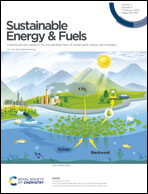Interface engineering of a hole-transport layer/perovskite with low-band-gap 2D-carbon nitrides for solar cell fabrication†
Abstract
Interfacial engineering can effectively improve the performance of solar cells by suppressing non-radiative recombination. The inherited ionic and hydrophilic nature of most semiconducting materials used for the hole-transport layer in perovskite solar cells (PSCs) makes them susceptible to moisture. This is one of the factors that compromises the long-term durability of PSCs. In this contribution, we report the synthesis and characterization of polymeric carbon nitride-based 2D materials with the composition C3Nx (where x = 3 or 5) and their placement as an interfacial layer between the hole-selective and perovskite layer in inverted PSCs. This interfacial engineering with 2D polymeric materials could suppress the redox reaction between Ni3+ in NiOx and organic cations present in perovskites to improve the stability. Such an interlayer could suppress the interfacial charge accumulation at the grain boundaries of perovskites and lower the non-radiative recombination, leading to a higher shunt resistance and amplified fill factor.



 Please wait while we load your content...
Please wait while we load your content...